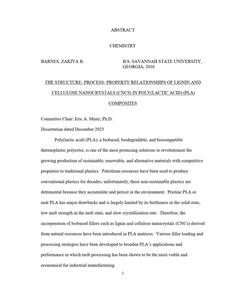- Collection:
- Atlanta University and Clark Atlanta University Theses and Dissertations
- Title:
- The Structure- Process- Property Relationships of Lignin And Cellulose Nanocrystals (CNCS) in Poly(LACTIC ACID) (PLA) Composites
- Creator:
- Barnes, Zakiya B., Clark Atlanta University
- Date of Original:
- 2023-12
- Subject:
- Degrees, Academic
Dissertations, Academic - Location:
- United States, Georgia, Fulton County, Atlanta, 33.749, -84.38798
- Medium:
- born digital
- Type:
- Text
- Format:
- application/pdf
- Description:
- Poly(lactic acid) (PLA), a biobased, biodegradable, and biocompatible thermoplastic polyester, is one of the most promising solutions to revolutionize the growing production of sustainable, renewable, and alternative materials with competitive properties to traditional plastics. Petroleum resources have been used to produce conventional plastics for decades; unfortunately, these non-sustainable plastics are detrimental because they accumulate and persist in the environment. Pristine PLA or neat PLA has major drawbacks and is largely limited by its brittleness in the solid state, low melt strength in the melt state, and slow crystallization rate. Therefore, the incorporation of biobased fillers such as lignin and cellulose nanocrystals (CNCs) derived from natural resources have been introduced in PLA matrices. Various filler loading and processing strategies have been developed to broaden PLA's applications and performance in which melt processing has been shown to be the most viable and economical for industrial manufacturing. Freeze-dried CNCs and lignin prepared by sulfuric acid hydrolysis were incorporated into PLA. We examined the behavior of three different lignin-to-cellulose ratios (30:70, 13:87, and 6:94) denoted as high lignin cellulose nanocrystals (HLCNCs-Na), medium lignin cellulose nanocrystals (MLCNCs), and low lignin cellulose nanocrystals (LLCNCs), respectively, incorporated into PLA at the total lignin content of 0.09 wt% and the CNCs content of 0.21 wt.%. Here, we report that low lignin ratios exhibit the highest degree of crystallinity. Next, we incorporated HLCNCs neutralized by NaOH (HLCNCs-Na) and KOH (HLCNCs-K), respectively, incorporated into PLA at 0.3, 0.6, 1.0, and 2.0 wt% filler loadings. While the HLCNCs-K/PLA were more difficult to disperse, there was an increase in the degree of crystallinity and mechanical properties. Last, we focused on carboxylated CNCs prepared by the TEMPO process and incorporated this near neutral biobased filler into PLA. We examined the dispersion of CNCs-COOH incorporated into PLA at 0.3, 0.6, 1.0, and 2.0 wt% filler loading. It was found that near neutral CNCs are compatible and facilitates debundling which improves the mechanical properties of PLA. Characterization was done by thermogravimetric analysis (TGA), dynamic mechanical analysis (DMA), differential scanning calorimetry (DSC), gel permeation chromatography (GPC), melt rheology, and optical microscopy.
- External Identifiers:
- Metadata URL:
- http://hdl.handle.net/20.500.12322/cau.td:2023_barnes_zakiya
- Rights Holder:
- Clark Atlanta University
- Original Collection:
- Atlanta University and Clark Atlanta University Theses and Dissertations
- Holding Institution:
- Atlanta University Center Robert W. Woodruff Library
- Rights:
-
